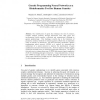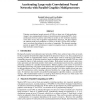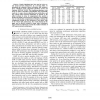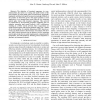619 search results - page 4 / 124 » On computational limitations of neural network architectures |
GECCO
2004
Springer
14 years 26 days ago
2004
Springer
The identification of genes that influence the risk of common, complex diseases primarily through interactions with other genes and environmental factors remains a statistical and ...
ICANN
2010
Springer
13 years 8 months ago
2010
Springer
Training convolutional neural networks (CNNs) on large sets of high-resolution images is too computationally intense to be performed on commodity CPUs. Such architectures however ...
CEC
2008
IEEE
13 years 9 months ago
2008
IEEE
Abstract-- Genetic algorithms have been used to evolve several neural network architectures. In a previous effort, we introduced the evolution of three well known ART architects; F...
CDC
2008
IEEE
14 years 1 months ago
2008
IEEE
— The detection of transient responses, i.e. non– stationarities, that arise in a varying and small fraction of the total number of neural spike trains recorded from chronicall...
NGC
2010
Springer
13 years 2 months ago
2010
Springer
A key to overcoming the limitations of classical artificial intelligence and to deal well with enormous amounts of information might be brain-like computing in which distributed re...




